pt-BR
nomes no trilho de navegação


Biomphalaria tenagophila is a species of air-breathing freshwater snail, an aquatic pulmonate gastropod mollusk in the family Planorbidae, the ram's horn snails.
This species is medically important pest,[3] because of transferring the disease intestinal schistosomiasis. (Intestinal schistosomiasis is the most widespread of all types of schistosomiasis).
The parasite Schistosoma mansoni, which Biomphalaria snails carry, infects about 83.31 million people worldwide.[4]
The shell of this species, like all planorbids is sinistral in coiling, but is carried upside down and thus appears to be dextral.
Biomphalaria tenagophila was originally discovered and described under the name Planorbis tenagophilus by the French naturalist Alcide d'Orbigny in 1835.[1] Orbigny (1835) referred its distribution to Corrientes Province, Argentina and to Santa Cruz Department, Bolivia (referred as "Santa-Cruz et Chiquitos"). But Orbigny himself later limited its distribution to Ensenada, Buenos Aires Province, Argentina in 1837.[5]
Subspecies recognized in this species include:
There are also three "old-style" proposals of subspecies, based on shell characteristics:[5]
History of discoveries summarized Paraense (2001).[7]
A cladogram showing phylogenic relations of species in the genus Biomphalaria:[8]
Biomphalaria Nilotic species complex Biomphalaria straminea complexBiomphalaria straminea
Biomphalaria sp.
Biomphalaria tenagophila
Biomphalaria sp. (? Biomphalaria havanensis)
Biomphalaria sp. (? Biomphalaria havanensis)
Biomphalaria tenagophila is a Neotropical[3] species and its native distribution include Peru,[9] Brazil, Uruguay[5] and Argentina.
This species has recently expanded its native range.[3][10]
The non-indigenous distribution of Biomphalaria tenagophila includes a hypothermal spring near Răbăgani, Romania (46°45´1.3´´N, 22°12´44.8´´E).[10]
The shell is sinistrally coiled (has left-handed coiling). The flat shells are yellow-brown, discoidal, deeply and symmetrically biconcave, and consist of 5 or 6 slowly increasing whorls. The last whorl is rounded; the intermediate whorls are slightly angled on the left side. The aperture is circular or slightly ovate and angled toward the left side of the shell (i.e., toward the upper surface on the bottom right shell). Fine, parallel, rib-like transverse lines can be seen on the outer surface of the whorls.[10]
The width of the shell is usually from 11 to 13 mm,[10] but in the largest individuals, the shell can reach 21 mm in width, 6.5 mm in height and have 6.5 whorls.[5]

The anatomy of this species was firstly published under the synonym Australorbis nigricans in 1955.[11]
The body length varies from 56 mm to 64 mm.[11]
The radula has from 125 to 168 rows of denticles (tiny teeth). The number of lateral teeth varying from 28 to 36. The mode radula formula is 31-0-31.[11]
The specific characteristics of the reproductive system of Biomphalaria tenagophila are: more than 200 diverticulae of the ovotestis; 7–11 main lobes of the prostate; and presence of vaginal pouch.[10]
Habitat of Biomphalaria tenagophila is tropical standing water or freshwater.[10]
Biomphalaria tenagophila is an intermediate host for Schistosoma mansoni and a vector of schistosomiasis.[12] Schistosoma mansoni came to Neotropics from Africa in context of the slave trade.[8] Schistosoma mansoni was not able to infect Biomphalaria tenagophila in 1916 and it has adapted to this host since 1916.[8]
Experimental parasites include:
This article incorporates public domain text from the reference.[10]
Biomphalaria tenagophila is a species of air-breathing freshwater snail, an aquatic pulmonate gastropod mollusk in the family Planorbidae, the ram's horn snails.
This species is medically important pest, because of transferring the disease intestinal schistosomiasis. (Intestinal schistosomiasis is the most widespread of all types of schistosomiasis).
The parasite Schistosoma mansoni, which Biomphalaria snails carry, infects about 83.31 million people worldwide.
The shell of this species, like all planorbids is sinistral in coiling, but is carried upside down and thus appears to be dextral.
Biomphalaria tenagophila adalah spesies siput air tawar dari famii Planorbidae. Spesies ini merupakan hama yang terkenal karena menjadi vektor penyebaran penyakit skistosomiasis usus.[3] Penyakit ini disebabkan oleh parasit Schistosoma mansoni yang telah menyerang 83 juta orang di seluruh dunia.[4]
Biomphalaria tenagophila awalnya ditemukan tahun 1835 oleh naturalis asal Prancis Alcide d'Orbigny yang menyebutnya dengan nama Planorbis tenagophilus[1] Penyebaran siput ini berada dalam rentang Provinsi Corrientes di Argentina hingga Santa Cruz di Bolivia, paling banyak ada di Ensenada, Buenos Aires, Argentina.[5]
Subspesies dari siput ini yaitu:
Nama lain yang pernah diusulkan yaitu:
Biomphalaria tenagophila merupakan organisme neotropis asli Peru, Brazil, Argentina, dan Uruguay.[3][7][5] Namun kini telah meluas hingga ke penjuru Amerika Selatan.[3][8] Hewan ini juga telah ditemukan terbawa hingga ke mata air dingin di Răbăgani, Rumania.[8]
Habitat Biomphalaria tenagophila secara spesifik berada di air tawar kawasan tropis.[8] Hewan ini merupakan vektor dan intermediate host bagi parasit Schistosoma mansoni penyebab penyakit skistosomiasis.[9] Parasit Schistosoma mansoni bukan asli Amerika Selatan, tetapi terbawa dari Afrika melalui perdagangan budak.[10] Schistosoma mansoni tidak mampu menginfeksi Biomphalaria tenagophila.[10]
Eksperimen telah dilakukan dengan mengujicobakan parasit Angiostrongylus vasorum yang tidak mampu menginfeksi manusia untuk menjangkiti siput ini.[11]
Biomphalaria tenagophila adalah spesies siput air tawar dari famii Planorbidae. Spesies ini merupakan hama yang terkenal karena menjadi vektor penyebaran penyakit skistosomiasis usus. Penyakit ini disebabkan oleh parasit Schistosoma mansoni yang telah menyerang 83 juta orang di seluruh dunia.
Biomphalaria tenagophila is een slakkensoort uit de familie van de Planorbidae.[1] De wetenschappelijke naam van de soort is voor het eerst geldig gepubliceerd in 1835 door D'Orbigny.
Bronnen, noten en/of referentiesBiomphalaria tenagophila é uma espécie de caramujo da família Planorbidae, hospedeiro intermediário do Schistosoma mansoni.[1]
Biomphalaria tenagophila é uma espécie de caramujo da família Planorbidae, hospedeiro intermediário do Schistosoma mansoni.